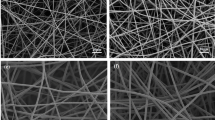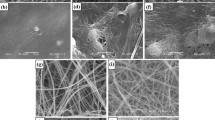Abstract
Sustained release cellulose acetate (CA) and ethyl cellulose (EC) polymer blend nanofibers loaded with ketoprofen (KET) were successfully prepared by electrospinning. Successful fiber formation has been investigated by using two different binary solvent systems, i.e., acetic acid + distilled water (2:1 v/v) and acetone + N,N-DMAc + ethanol (2:1:1 v/v). Scanning electron microscopy (SEM) images showed that morphological features gradually change as the ratio of both polymers change. Nanofiber diameter also decreases as the CA content is increased in the polymer blend solution from 77.25 ±27 to 72.39 ±30 nm. Drug release profiles were evaluated by in-vitro drug release experiments. Drug release follows a pseudo-Fickian behavior of diffusion and shows a sustained release mechanism. Nanofibers containing more CA show greater controlled release capacity as compared to EC. X-ray diffraction (XRD) patterns of CA and EC polymer blend nanocomposites show that crystalline ketoprofen has changed into an amorphous state. Fourier transform Infrared (FTIR) analysis indicates hydrogen bonding occurs between the drug and the polymer, accounting for molecular integration of the two components. The thermal stability of the prepared polymer blend was also studied using thermo-gravimetric analysis (TGA). A polymer blend sustained release drug delivery system prepared by electrospinning make it possible to fabricate other novel drug releasing systems.









Similar content being viewed by others
References
el Kenawy R, Bowlin GL, Mansfield K, Layman J, Simpson DG, Sanders EH, Wnek GE (2002) Release of tetracycline hydrochloride from electrospun poly(ethylene-co-vinylacetate), poly(lactic acid), and a blend. J Control Release Off J Control Release Soc 81(1–2):57–64
Sajitha CJ, Mohan D (2003) Studies on cellulose acetate–carboxylated polysulfone blend ultrafiltration membranes—Part II. Polym Int 52:138–145
You SWL Y, Youk JH, Min BM, Lee SJ, Park WI (2005) In vitro degradation behaviour of non-porous ultra-fine poly(glycolic acid)/poly(L-lactic acid) fibers and porous ultra-fine poly(glycolic acid) fibres. Polym Degrad Stab 90:441–448
Lannutti DR J, Ma T, Tomasko D, Farson D (2007) Electrospinning for tissue engineering scaffolds. Mater Sci Eng C 27(3):504–509
Yoon YI, Moon HS, Lyoo WS, Lee TS, Park WH (2008) Superhydrophobicity of PHBV fibrous surface with bead-on-string structure. J Colloid Interface Sci 320(1):91–95. doi:10.1016/j.jcis.2008.01.029
Lee HYK KH, Bang HJ, Jung YH, Lee SG (2003) The change of bead morphology formed on electrospun polystyrene fibers. Polymer 44(14):4029–4034
Lee SG KH, Chase DB, Rabolta JF (2006) Electrostatic polymer processing of isotactic poly(4-methyl-1-pentene) fibrous membrane. Polymer 47(23):8013–8018
Vollrath F, Edmonds DT (1989) Modulation of the mechanical properties of spider silk by coating with water. Nature 340(27):307–307
AL Y (1993) Free liquid jets and films: hydrodynamics and rheology. Wiley, New York, p 446
Zhou JH W, Cui S, Gao W (2011) Studies of electrospun cellulose acetate nanofibrous membranes. Open Mater Sci J 5:51–55
Konwarh R, Karak N, Misra M (2013) Electrospun cellulose acetate nanofibers: the present status and gamut of biotechnological applications. Biotechnol Adv 31(4):421–437. doi:10.1016/j.biotechadv.2013.01.002
Deng XZ H, Wang X, Zhang C, Ding B, Zhang Q, Du Y (2010) Layer-by-layer structured polysaccharides film-coated cellulose nanofibrous mats for cell culture. Carbohydr Polym 80(2):474–479
Xing C, Wang H, Hu Q, Xu F, Cao X, You J, Li Y (2013) Mechanical and thermal properties of eco-friendly poly(propylene carbonate)/cellulose acetate butyrate blends. Carbohydr Polym 92(2):1921–1927. doi:10.1016/j.carbpol.2012.11.058
Shibata T (2004) Cellulose acetate in separation technology. Macromol Symp 208(1):353–370
Wongsasulak MP S, Weiss J, Supaphol P, Yoovidhya T (2010) Electrospinning of food-grade nanofibers from cellulose acetate and egg albumen blends. J Food Eng 98(3):370–376
Wu XM, Branford-White CJ, Zhu LM, Chatterton NP, Yu DG (2010) Ester prodrug-loaded electrospun cellulose acetate fiber mats as transdermal drug delivery systems. J Mater Sci Mater Med 21(8):2403–2411. doi:10.1007/s10856-010-4100-y
Ma MK Z, Ramakrishna S (2005) Electrospun cellulose nanofiber as affinity membrane. J Membr Sci 265(1–2):115–123
Abou-Zeid AIW NY, Kandile NG, Rushdy AA, El-Sheikh MA, Ibrahim HM (2011) Preparation, characterization and antibacterial properties of cyanoethylchitosan/cellulose acetate polymer blended films. Carbohydr Polym 84(1):223–230
Khatri KW Z, Kim BS, Kim IS (2012) Effect of deacetylation on wicking behavior of co-electrospun cellulose acetate/polyvinyl alcohol nanofibers blend. Carbohydr Polym 87(3):2183–2188
Huang LYYD, Branford-White C, Zhu LM (2012) Sustained release of ethyl cellulose micro-particulate drug delivery systems prepared using electrospraying. J Mater Sci 47:1372–1377
Murtaza G (2012) Ethylcellulose microparticles: a review. Acta Pol Pharm 69(1):11–22
Chengyao QJ W, Jiangang X, Christopher BW, Limin Z, Yang Y, Yajuan W (2011) Preparation and controlled release of degradable polymeric ketoprofen–saccharide conjugates. Polym Bull 67:593–608
Han SOYJ, Min KD, Kang YO, Park WH (2008) Electrospinning of cellulose acetate nanofibers using a mixed solvent of acetic acid/water: Effects of solvent composition on the fiber diameter. Mater Lett 62(4–5):759–762
Liu HTC (2007) Electrospinning of cellulose acetate in solvent mixture N, N-Dimethylacetamide (DMAc)/Acetone. Polym J 39(1):65–72
Yan JYD (2012) Smoothening electrospinning and obtaining high-quality cellulose acetate nanofibers using a modified coaxial process. J Mater Sci 47:7138–7147
Son WKYJ, Lee TS, Park WH (2004) Electrospinning of ultrafine cellulose acetate fibers: studies of a new solvent system and deacetylation of ultrafine cellulose acetate fibers. J Polym Sci B 42:5–11
Kamal FMA-E H, Lotfy S (2014) Characterization and some properties of cellulose acetate-co-polyethylene oxide blends prepared by the use of gamma irradiation. J Radiat Res Appl Sci 7:146–153
Pronoy K, Chatterjee CMC (1968) Thermogravimetric analysis of cellulose. J Polym Sci A Polym Chem 6(12):3217–3233
Acknowledgments
This work was supported by the Langsha Group, Jofo (WeiFang) Nonwoven Co. Ltd and the UK-CHINA Joint Laboratory for Therapeutic Textiles.
Author information
Authors and Affiliations
Corresponding author
Rights and permissions
About this article
Cite this article
Um-i-Zahra, S., Shen, X.X., Li, H. et al. Study of sustained release drug-loaded nanofibers of cellulose acetate and ethyl cellulose polymer blends prepared by electrospinning and their in-vitro drug release profiles. J Polym Res 21, 602 (2014). https://doi.org/10.1007/s10965-014-0602-5
Received:
Accepted:
Published:
DOI: https://doi.org/10.1007/s10965-014-0602-5




